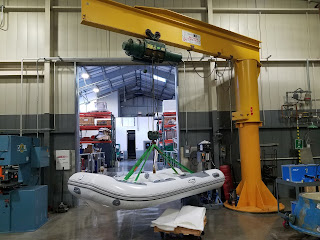Lots of pictures here to catch up with our big dinghy upgrade project.
Looking ahead to our cruising plans, it was that we need a dinghy with the following features:
Good motor with speed to cover distance when needed for remote anchorages, exploring, and diving.
Ability to carry lots of cargo
Easy to pull up on a sand or gravel beach
While great for rowing, our fiberglass whitehall style skiff didnt really hit the mark as well as a RIB on all of the above. If we had room, I definitely would try to cruise with both, but with only room for one, the RIB makes a lot more sense. So, we said a sad goodbye to our rowing skiff and used the proceeds to help fund a new RIB and outboard:
I spent some time on Craigslist looking for a used boat and motor, but it seems most of the RIBs are pretty beat by the time they go up for sale. So we started looking at buying new.
After looking at a lot of makes and models, the Achilles stood out for us as the best fit. They are heavily constructed, good workmanship, and middle of the pack price-wise. We went with the 315DX which is a fiberglass double bottom style, about 10.5 feet long, about 150 lbs, with a max capacity of 1300lbs (including motor and gear). I considered an aluminum hulled RIB too, but I think the extra weight of the fiberglass hull is a plus, and fiberglass is quieter on the water than aluminum.
Despite some questionable handling by the shipping company (is "do not stack" really that complicated of a concept?), the boat and motor were ok when unboxed and setup:
We made a few upgrades while the boat was in the shop (and easy to work on).
The first upgrade was a keel guard to protect the bottom. The install took some care, but it was pretty straightforward:
Also installed a set of Danard dinghy wheels (highly recommended).
These are much heavier construction than the competition, and have a clever design that uses no clips or other loose hardware to install, remove, and lock the wheels in the up or down position. With the wheels down, I can roll the boat around on my own onshore, which is pretty handy:
Reinstalling the motor when we got the dinghy home, gave us a chance to try our aft boom crane.
We used it to pick the outboard from the dock next to the boat, swing it over the stern, and lower it onto the dinghy tied along the opposite side. Overall the rigging worked great. I just need to do a little work on the lead from the boom lift to the winch on the mast - it had a tendency to over-ride under tension:
The motor is a Tohatsu 15hp 4-stroke, with electronic fuel injection. Current wisdom says that the fuel injection is likley to have less issues with stale fuel and ethanol than carbureted engines.
Here's some pics with the cover off. Pretty neat design:
First few startups and break-in runs were problem free. With just the two of us onboard it gets up and goes nicely, even at half throttle:
I'm still breaking in the engine, but so far it has been a solid performer that always starts on the first or second pull, and runs smooth and quiet. Even though the fuel injection system is technically sealed, I added a small water trap/fuel filter just before the motor to catch any residual crud or moisture from the tank. The stainless tube shown in front of the motor is a motor lock to make it a little more challenging to steal:
I added a hydrofoil to the cavitation plate to help get up on plane a little easier, and a quick connect flushing fitting for rinsing out the cooling system with fresh water after each run. The hose from our aft deck shower now has a matching fitting, and its very easy to plug in and flush all the salt out of the motor when its hanging on the davits. In my limited experience with outboards, keeping the motor flushed with fresh water is one of the most important things you can do to give your outboard
a long life:
The new dighy w/ motor is about 125lbs heavier than the old skiff, so I changed the lifting tackle from 5:1 to 6:1 with bigger blocks, and jam cleats to lock the line without tying off if you need to take a rest or reset. This makes the extra weight a little easier to manage.
I've got the davits dialed in pretty nicely for the new dinghy now, with some chocks (1" starboard with carpet on the face) that capture and stabilize the sides of the boat when it is cranked up all the way on the davits. With the addition of a couple of ratchet straps, this will be fine for calm weather inshore cruising. For rougher conditions and offshore, I'll need to fabricate a set of cradles and tie-downs on the aft deck. The boat plus motor is a little too long for on-deck storage so we'll have to make a rail mount bracket for storing the motor when we carry the boat on deck. A couple of projects for another day...



































No comments:
Post a Comment